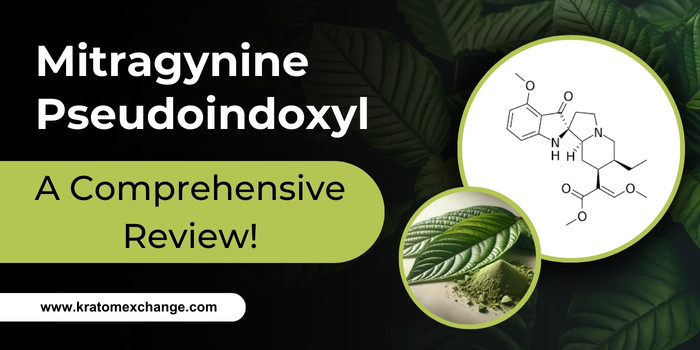Mitragynine pseudoindoxyl, derived from the Kratom plant (Mitragyna speciosa), has garnered attention for its unique effects on the body. This compound shows promise in providing benefits such as increased energy, mood enhancement, and relaxation.
Research suggests that mitragynine pseudoindoxyl acts as an atypical opioid agonist, binding to receptors in the brain, which contributes to its relieving and mood-boosting effects. It can stimulate energy and motivation in lower doses, while higher doses may promote relaxation and calmness (Kratom.org) (ACS Lab).
Alkaloids in Kratom
Kratom is rich in a variety of alkaloids, which are natural compounds responsible for the plant’s diverse effects. The primary alkaloid in Kratom is mitragynine, which is renowned for its stimulating and analgesic properties.
Through scientific processes, mitragynine can be chemically modified to produce mitragynine pseudoindoxyl. This derivative possesses unique characteristics and potential benefits distinct from the original compound.
How Does It Work?
Mitragynine pseudoindoxyl works in a unique way. Most discomfort relievers, like substances, target the mu receptors in the brain to reduce uneasiness. However, this often leads to problems like tolerance (needing more of the drug to get the same effect) and dependence (relying on the drug to function).
Mitragynine pseudoindoxyl also targets the mu receptors but does so in a way that might reduce these problems. It acts as an agonist at the mu receptors, meaning it activates them to relieve suffering.
At the same time, it acts as an antagonist at the delta receptors, which can help reduce the risk of developing tolerance and dependence. It also partially activates the kappa receptors, adding another layer to its pain-relief properties.
Potential Benefits of Mitragynine Pseudoindoxyl
While research is still in its early stages, mitragynine pseudoindoxyl holds promise for several potential benefits:
Energy Boost: Similar to mitragynine, mitragynine pseudoindoxyl may help increase energy levels and reduce fatigue, making it appealing to those seeking a natural stimulant.
Mood Enhancement: Users of Kratom often report improved mood and a sense of well-being. Mitragynine pseudoindoxyl may contribute to these effects by interacting with certain receptors in the brain.
Relaxation: In addition to its stimulating properties, mitragynine pseudoindoxyl may promote relaxation and reduce anxiety, providing a balanced effect that can be
Legal Status Around the World
The legal status of mitragynine pseudoindoxyl, like many compounds derived from Kratom, varies widely across different countries:
• United States: Kratom itself is legal in most states, but the legality of its derivatives, including mitragynine pseudoindoxyl, is less clear and can vary. The Food and Drug Administration (FDA) and the Drug Enforcement Administration (DEA) have expressed concerns about Kratom’s safety and potential for abuse. Some states have banned Kratom, while others allow its use and sale.
• Canada: Kratom is legal, but it’s not approved for ingestion. This means that while you can buy Kratom, it’s not legally allowed to be marketed for consumption. The legal grey area makes it difficult to navigate its use and availability.
• Europe: The legal status varies by country. For example, Kratom is banned in countries like Denmark, Poland, and Sweden, while it remains legal in others like Germany and the Netherlands. This patchwork of regulations reflects differing national attitudes towards the substance and its potential risks and benefits.
• Asia: In Thailand, Kratom has recently been decriminalized, but its derivatives might still face legal restrictions. In Malaysia and Myanmar, Kratom is illegal. Given that Kratom is native to Southeast Asia, these varying regulations impact both local use and international trade.
• Australia: Kratom and its derivatives are classified as controlled substances and are illegal to possess or sell. Australia’s strict drug laws reflect a cautious approach to new psychoactive substances.
The variability in legal status highlights the need for international consensus and more research to guide regulation. As scientific understanding of mitragynine pseudoindoxyl grows, regulations may evolve to better reflect its risks and benefits.
Current Research and Future Directions
Despite its promising profile, mitragynine pseudoindoxyl remains primarily within the realm of preclinical research. Limited human studies have been conducted, and comprehensive clinical trials are necessary to fully understand its efficacy and safety in humans.
Regulatory challenges also loom large, particularly given the compound’s structural similarities to other controlled substances. The legal status of Kratom and its derivatives varies widely across different jurisdictions, impacting the pace and direction of research.
Future research priorities include:
• Long-Term Effects: Studying the long-term effects of mitragynine pseudoindoxyl on the human body to ensure its safety for extended use.
• Optimization of Synthesis: Developing methods for the efficient, large-scale production of mitragynine pseudoindoxyl to meet potential medical demand.
• Clinical Trials: Conducting robust clinical trials to establish its therapeutic potential and safety profile in human patients.
• Regulatory Guidance: Working with regulatory bodies to develop guidelines that ensure safe and effective use of mitragynine pseudoindoxyl.
Conclusion
Mitragynine pseudoindoxyl represents a promising frontier in uneasiness management. Its unique pharmacological properties, distinct from traditional substances, offer hope for effective and safer therapeutic alternatives.
However, significant research and regulatory hurdles must be addressed to unlock its full potential and bring this compound from the lab bench to clinical practice. As the scientific community continues to explore and understand this compound, it may eventually play a crucial role in modern medicine’s fight against discomfort and recovery. addiction.


